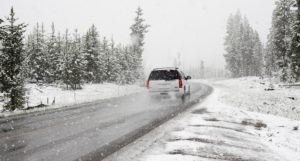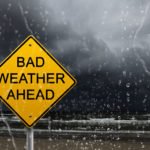- Colorado driving conditions are unique from many other areas of the country, and drivers need to be aware of expected road conditions before venturing onto local roads
- There is a wide range of risks and hazards that can make it dangerous to drive on Colorado roads
- Drivers need to ensure that their auto insurance policy is updated at all times and should keep an emergency kit in their vehicle
Situated in the heart of North America, Colorado is a land-locked state that is known for its mountainous terrain and gorgeous scenery.
While there are plains to the east, the Rocky Mountains and surrounding foothills create significant elevation changes across the state. The mountains also significantly influence weather conditions at all elevation levels.
Colorado is a state that has all four seasons, but the tallest peaks in the state may mostly have winter-like weather conditions almost year-round. Drivers should be prepared to experience all types of weather conditions while driving through the state regardless of the season.
Dressing in layers and ensuring that you pack a jacket are smart ideas, and drivers also need to prepare their vehicles for all types of weather conditions before venturing out.
Each season has a typically standard length of a few months at the lower elevations, but the climate tends to be more winter-like and cold at higher elevations in the state.
A driver may depart on a road trip in summer weather conditions, but an elevation change can result in the driver passing through snowy and icy conditions within a very short period of time.
All Colorado drivers need to know how to drive in a wide range of weather and road conditions for optimal safety.
If you’d like your car to better weather Colorado, enter your ZIP code above and compare at least three to four policies today!
General Driving Tips for Bad Weather in Colorado
With steep inclines in locations throughout the state, snow and ice commonly found on the roads, wildlife on or near roads, and other factors, driving in Colorado can be dangerous at times.
All drivers should prepare their vehicles properly before driving, which includes keeping the car maintained in great condition with periodic repairs and maintenance work as needed.
You should ensure that your windshield wipers, headlights, brakes, and other critical components are in good condition. Schedule a regular maintenance service for your vehicle per the manufacturer’s recommendations is a smart idea.
Drivers may also benefit from stocking the car with an emergency kit. This kit may include everything that you need to stay safe on the road in Colorado if you experience a breakdown, with things like:
- A blanket
- An ice scraper
- Bear spray
- Bottled water
- Canned food, etc.
Remember to review and update your emergency kit regularly so that you are always prepared for a worst-case scenario when driving through this beautiful state.
Free Car Insurance Comparison
Compare Quotes From Top Companies and Save
What to Do in Certain Weather Conditions in Colorado
https://www.youtube.com/watch?v=HZTgmC0Pmb8
Snowy and icy roads are common in Colorado, and you should be aware that these conditions could be present during even the warmest months of the year at higher elevations. When driving in the snow or ice, consider using these tips to stay safer on the roads:
- Reduce your speed, and this is particularly important when driving on a steep incline.
- Always use your headlights regardless of the time of day.
- Understand the proper techniques to maneuver out of a skid safely.
- Ensure that your car’s tires have ample tread for the weather conditions that you plan to drive through.
https://www.youtube.com/watch?v=vGVEdeqjSLE
Rain is also common in Colorado throughout the year, and these tips apply specifically to rainy conditions.
- Do not use cruise control when driving in the rain.
- Leave a safe distance between you and the car in front of you.
- Reduce speed based on your visibility and the rate of rainfall.
- Increase the distance between you and the car in front of you to allow for slower braking times when roads are slick.
In many instances, Colorado drivers will need to pass through the mountains, which requires additional safety techniques.
- Downshifting as you cruise down hills and mountains is important to avoid unnecessary wear on your brakes. If you notice that your brakes are overheating, pull over to allow them time to cool off.
- Avoid using the air conditioner as this could result in a loss of engine power.
- Allow faster vehicles to pass you safely.
- Be aware of abundant wildlife in the mountain areas. Understand that the wildlife — as well as other drivers who have pulled over to view wildlife — can be hazardous.
What will aid you in bad weather?
Because bad weather conditions are common in Colorado in all seasons, drivers should be prepared for these conditions before venturing onto the roads.
In addition to ensuring that your vehicle is properly maintained and that you have an emergency kit in your car, review your auto insurance policy.
— Comprehensive Coverage
Comprehensive auto insurance is an excellent type of coverage to consider. This kind of coverage offers benefits that include repairs on your own car if you are in an accident, if your car is stolen, and more.
Be aware that the state does not legally require you to purchase comprehensive insurance, but you must comply with the state’s minimum liability insurance requirements.
The coverage type as well as limits that you select can impact your premium cost as well as your out-of-pocket costs if you are involved in an accident. Consider buying the most effective and complete coverage that you can afford.
— Roadside Assistance
Colorado drivers should also remember the need to use roadside assistance from time to time. You may qualify for roadside assistance through your car dealership or manufacturer, through your auto insurance company, or through other sources.
In many cases, roadside assistance is free of charge and may be included with another service or feature that you have purchased; however, some sources for roadside assistance may require you to pay a deductible or another small fee each time you request assistance.
Roadside assistance should only be used in non-emergency situations, such as if you need help changing a flat tire or if you run out of gas.
If you are dealing with a serious or life-threatening situation, you should call 911 for fast assistance from first responders.
For example, roadside assistance should not be used if you are in a car accident, and it is more appropriate to call 911 for professional assistance if you are involved in this type of serious situation on Colorado roads.
— Comparison Shopping
Regardless of whether you choose to buy a comprehensive insurance policy or a different kind of coverage in Colorado, you should compare new rate quotes twice per year.
Use the Internet to save money when you ask for car insurance quotes from at least three different providers, and always ask for quotes on similar coverage types and limits to make the comparison process faster and easier to complete.
Remember that choosing a higher deductible can result in a lower premium amount, which is a convenient way to adjust the price of your auto insurance premium in Colorado.
If you’re looking for a better and more affordable auto insurance policy, start comparison shopping today by entering your ZIP code below!





